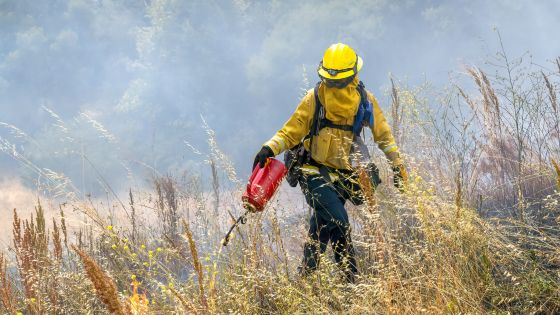Imagine standing among the charred remains of a once-thriving forest. You’re not just a witness but a healer, armed with knowledge and strategies to replace burned wildlife habitat and protect critical cultural resources in this scarred landscape.


Dive deep into the essential tools for forest wildfire restoration, from understanding the fire’s impact to replanting native species. It’s an arduous journey, but with every seed you plant, you’re rebuilding an ecosystem.
Understanding forest wildfires
Understanding forest wildfires isn’t simply about knowing how they start. It’s about recognizing their profound implications for a threatened and endangered habitat. Fire-damaged lands suffer from significant biodiversity loss and ecosystem function disruption.
Post-fire recovery is often slow and hindered by recurring fires and critical safety hazards, making burned area rehabilitation and forest restoration complex and lengthy.
To foster forest restoration, you need a comprehensive understanding of wildfires, their impacts, and the intricate dynamics of post-fire recovery.
Prioritizing erosion control measures
While understanding the impacts of wildfires is crucial, it’s equally essential that you prioritize erosion control measures in your forest restoration strategies.
Post-fire actions must include measures to minimize potential soil erosion. Burned area rehabilitation can’t succeed without focusing on erosion control.
You should incorporate comprehensive plans to install erosion control measures as a priority. These measures may include using physical barriers like the Granite Seed wattles, seeding areas with quick-growing vegetation, or using mulch to protect bare soil.
A detailed analysis of site-specific conditions, including terrain features and rainfall patterns, can guide the design of these controls.
By investing time and resources in these measures, you’ll ensure the long-term viability of your restoration efforts, safeguarding against the damaging effects of erosion.
Basics of Forest Restoration
After prioritizing erosion control, your next step is understanding forest restoration fundamentals. It’s pertinent to grasp that wildfire restoration isn’t merely about planting trees. It’s a complex, systematic process that involves the forest service and scientists to aid in rehabilitation efforts.
A critical aspect of these strategies for forest wildfire restoration is reintroducing native vegetation. Native plants are adapted to local conditions, improving their survival chances.
They also play essential roles in the ecosystem, providing habitat and food for native wildlife. Furthermore, they help restore the soil’s structure and fertility, aiding other plants’ growth.
In essence, forest restoration entails a holistic, well-planned approach to revive the health and resilience of the forest ecosystem.
Post-wildfire soil treatment
In restoring a forest after a wildfire, one of your crucial tasks involves treating the soil to ensure it’s conducive to the growth of native vegetation.
Post-fire, immediate actions must be taken to assess the severity of soil damage and implement emergency stabilization measures.
It’s also essential to replace burned pasture fences as quickly as possible to promote the recovery of native species.
Treating noxious weed infestations that thrive due to post-fire conditions and fire suppression efforts is another priority. These weeds can outcompete native species, disrupting the restoration process.
Therefore, a systematic, science-based approach to soil treatment is instrumental in the successful recovery of a forest following a wildfire.
Replanting strategies after fires
Having assessed and treated the soil, you’re now ready to begin the crucial task of replanting the forest after the fire. Your goal in developing replanting strategies after fires should be to remove critical safety hazards, restore the burned habitat, and re-establish native plant communities.
To do so, replace safety-related facilities that were burned and prioritize native species in your replanting efforts.
These species have evolved with fire and are more likely to thrive post-fire, contributing to a healthier, more resilient forest.
Role of native species
Given the importance of understanding the needs of different tree species, you’ll find that native species play a pivotal role in restoring a fire-damaged forest.
These indigenous trees provide a crucial wildlife habitat, supporting threatened and endangered species. Their presence helps prevent the spread of invasive species, which can exacerbate fire damage.
By monitoring fire effects on native species, you can adjust restoration strategies to improve fire-damaged areas and minor safety-related facilities for wildlife habitat.
The importance of watershed rehabilitation
The importance of watershed rehabilitation lies in its ability to mitigate erosion, maintain water quality, and reduce the risk of future fires.
After a wildfire, a burned area emergency response is initiated to assess the fire’s effects and implement actions to restore the watershed.
This step is crucial to monitoring fire effects, especially erosion, which can severely degrade water quality and exacerbate the impacts of future fires.
Utilizing salvage logging
In your wildfire restoration efforts, you’ll find that a significant portion of the strategy involves salvage logging, a process that’s essential for mitigating fire risks and promoting forest rejuvenation.
Salvage logging involves the removal of burned trees and replacing burned fences on federal lands post-fire. This action reduces fuel for potential future fires and aids fire suppression activities.
This process also clears the way for the establishment of hand and dozer lines, which are vital for containing fires.
However, it’s crucial to balance salvage logging with the need for ecological recovery. Excessive logging can impair forest regeneration. So, you must tread carefully, considering both the immediate need for fire control and the long-term health of the forest ecosystem.
Monitoring and maintenance post-restoration
Once you’ve completed the restoration process, it’s crucial to implement a comprehensive monitoring and maintenance plan to ensure the ongoing health and resilience of the restored forest.
This step is a rigorous and competitive process spanning up to five years. Monitoring and maintenance post-restoration involves consistent checks for early signs of disease, pest infestations, and environmental stressors.
You should implement early detection systems for these potential threats. It will help in timely intervention and protect recovering areas from further damage.
Last words
In restoring wildfire-ravaged forests, your strategies must be as multifaceted as the ecosystem itself. No matter the type of trees, there’s a way to prevent environmental damage by being prepared for all nature has to offer. From prioritizing erosion control to preserving native species, each step is monumental. Remember, the magnificence of a forest doesn’t return overnight. Regular monitoring and maintenance are crucial. Even the seemingly insignificant act of salvage logging can play a colossal role.


























